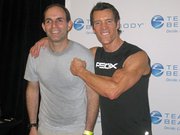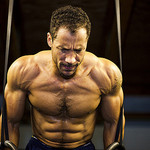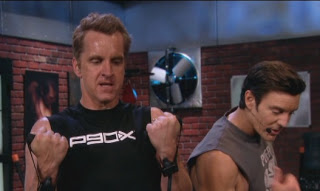I have passed the halfway mark of P90X2, Round 2, as I am (mostly) documenting on my YouTube channel. I recently entered Phase 2, the so-called Strength Phase, which most closely resembles the exercises from P90X. One of the workouts even shares the same name: X2 Shoulders and Arms. I thought it would be fun to compare P90X Shoulders and Arms to the P90X2 version, as a quick overview of the differences between the two programs.
The Cast
First, let’s talk about the cast. It’s not really relevant as a comparison of the workouts, but maybe it shows how the program has grown over the years. (Note the links to their respective cast profiles, too!
P90X
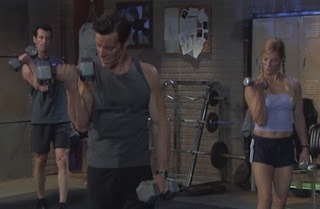 |
| Joe, Tony and Drea doing Full Supination Concentration Curls |
Joe Bovino is an attorney who obviously enjoys heavy lifting as a hobby. His triceps were “Diamonds of Gold” (Huh?). He was a graduate of the original P90X test group.
Daniel Haas was one of Tony’s “Sunday workout buddies.” There are a few videos documenting these workouts, which are a combination of rope climbing and gymnastics on bars. (Here is one example.) Anyway, if Daniel participated in these workouts, he was ready for P90X.
Dreya Weber is a trapeze artist, show producer, and choreographer. She was included in several P90X DVDs. Here she demonstrated the “lean” style, 10-15 repetitions with lighter weights.
P90X2
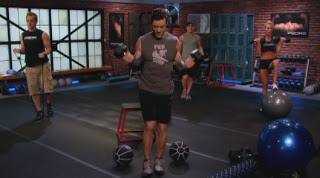 |
| Balance Curls, on one leg |
Monica Parodi is a P90X graduate whose dramatic transformation changed her life. She became a Team Beachbody coach in 2010, and jumped at the chance to audition for P90X2 in 2011. She is a vegan, a bodybuilder, and a mother of three, including twins.
Jason Scheff has been a friend of Tony Horton since the 1980s, and a personal training client in 1989-1992. He has completed at least 8 rounds of P90X, and one round of Insanity. He is a Team Beachbody coach. He is also a professional musician, the lead singer for the group Chicago, with a long and successful career.
Josh Spencer is a former financial advisor who became a full-time Team Beachbody coach in less than two years. He was a P90X graduate, and Tony either liked or hated him because of his bulging arms.
The Workouts
Now, here is an overview of the exercises in both workouts. The worksheets are available for free on the Beachbody website.
P90X
 |
| “Use your worksheet!” Tony says |
There are five sets of six exercises each. The last set is a “Bonus Round” if you’re ready for it. Technically, this is a shoulders, biceps, and triceps workout, so the exercises are related to that sequence. A shoulder press (or shoulder fly) is followed by a bicep curl, then a tricep kickback. There are slight variations, such as the upright row, chair dip, etc. This workout introduced me to more bicep curl variations than I ever knew existed!
According to my heart rate monitor, this is the least aerobic of the P90X workouts. You’re standing firmly on the ground, lifting heavy weights (except for the Chair Dips, or Side-Tri Rises, but you get the idea). I believe this is what Tony calls “Good old-fashioned American work!” My arms are always sore after this workout, of course, and a couple of hours later, I usually get some intense protein cravings. Does anyone have a really big steak?
P90X2
 |
| The worksheet’s back! In color! |
Almost 10 years after P90X was developed, P90X2 was created using the principles of “Functional Fitness,” including the development of core muscles and balance. The X2 Shoulders + Arms workout does not appear in the first phase of the program, as it did in P90X; it is in Phase 2, the Strength Phase.
There is one set of exercises, repeated three times (no bonus round): Balance Curl, Arnold Press (alternate arms), Overhead Tricep Pull, Six Direction Shoulder Fly, Crazy Eight, Y-T Fly, and Rocket Launcher Tricep Kickback. You can see the pattern of shoulders/biceps/triceps again. There’s a lot less variety than the P90X version, but added difficulty. Now, instead of planting our feet and bending our knees slightly, we are encouraged to raise one foot, or place it on a stability ball. We learn that instability challenges our bodies, and makes us more adaptable.
This version of Shoulders and Arms is a little more aerobic. OK, it’s still no cardio workout, by any means. It engages the core and stabilizing muscles to a greater extent than the original. On the other hand, there is less emphasis on lifting heavy weights. (Tony asks sarcastically, “Are you trying out for the Bicep Team?”) Generally the sets are performed with lower weights, more repetitions. A large stability ball, commonly used in P90X2, doubles as a weight bench or step for certain exercises.
Analysis/Conclusion
 P90X2 is not intended to be a “more difficult version of P90X,” although in some respects it is, of course. If it was exactly the same, what would be the point? P90X2 puts less emphasis on heavy lifting, and there are fewer individual exercises per workout. Tony Horton emphasized proper form in P90X, but P90X2 takes it to the next level. If you’ve got a heavy-ish weight in one hand, and you’re standing on one foot, then you’d better be using good form!
P90X2 is not intended to be a “more difficult version of P90X,” although in some respects it is, of course. If it was exactly the same, what would be the point? P90X2 puts less emphasis on heavy lifting, and there are fewer individual exercises per workout. Tony Horton emphasized proper form in P90X, but P90X2 takes it to the next level. If you’ve got a heavy-ish weight in one hand, and you’re standing on one foot, then you’d better be using good form!
Tony Horton’s intention with P90X was to bring bodybuilding concepts, plyometrics, and yoga to the masses. Oh, and don’t forget about Muscle Confusion! Now in P90X2, he’s incorporated the aforementioned Functional Fitness, influences from the Peak Performance Project, and more. It’s definitely a follow up to P90X rather than a replacement. I’ve seen at least one P90X/P90X2 hybrid workout schedule already, developed by P90X2 cast member Sean Callahan.
I hope this comparison of two workouts has helped to explain the similarities and differences between the programs. You can start with either one, you can follow one program for 90 days, and then use the other (or apparently create a hybrid). As Tony likes to say, “It’s all good.” 
If this blog post has helped you, please consider using the affiliate advertising links on this page. Your purchase supports the blog at no additional cost to you. Thanks!
Related Links
Beachbody Video: The Difference Between P90X and P90X2 (YouTube)


